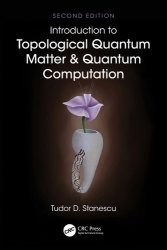 Название
Название: Introduction to Topological Quantum Matter & Quantum Computation, 2nd Edition
Автор: Tudor D. Stanescu
Издательство: CRC Press
Год: 2024
Страниц: 449
Язык: английский
Формат: pdf (true)
Размер: 10.1 MB
What is "topological" about topological quantum states? How many types of topological quantum phases are there? What is a zero-energy Majorana mode, how can it be realized in a solid-state system, and how can it be used as a platform for topological quantum computation? What is quantum computation and what makes it different from classical computation?
Addressing these and other related questions, Introduction to Topological Quantum Matter & Quantum Computation provides an introduction to and a synthesis of a fascinating and rapidly expanding research field emerging at the crossroads of condensed matter physics, mathematics, and computer science. Providing the big picture and emphasizing two major new paradigms in condensed matter physics – quantum topology and quantum information – this book is ideal for graduate students and researchers entering this field, as it allows for the fruitful transfer of ideas amongst different areas, and includes many specific examples to help the reader understand abstract and sometimes challenging concepts. It explores the topological quantum world beyond the well-known topological insulators and superconductors and unveils the deep connections with quantum computation. It addresses key principles behind the classification of topological quantum phases and relevant mathematical concepts and discusses models of interacting and noninteracting topological systems, such as the toric code and the p-wave superconductor. The book also covers the basic properties of anyons, and aspects concerning the realization of topological states in solid state structures and cold atom systems.
Topological quantum computation is also presented using a broad perspective, which includes elements of classical and quantum information theory, basic concepts in the theory of computation, such as computational models and computational complexity, examples of quantum algorithms, and key ideas underlying quantum computation with anyons. This new edition has been updated throughout, with exciting new discussions on crystalline topological phases, including higher-order topological insulators; gapless topological phases, including Weyl semimetals; periodically-driven topological insulators; and a discussion of axion electrodynamics in topological materials.
The fundamental tasks of quantum computation can be summarized as follows:
I. Develop quantum computational models. The fundamental model of quantum computation is the quantum circuit model, which defines a computation as a sequence of quantum gates – the quantum analog of classical logic gates. It can be demonstrated that there is a small set of so-called universal gates with the property that any quantum computation can be expressed in terms of these gates.
II. Design quantum algorithms. The fundamental underlying question concerns the ultimate limits of quantum computation. What class of computations can be performed using a quantum computer? Are there computational tasks that a quantum computer can perform better than a classical computer? So far, there are only a few examples of quantum algorithms that provide an advantage over known classical algorithms. Examples include the Deutsch–Jozsa and Shor algorithms, quantum search algorithms (e.g., the Grover algorithm), and quantum simulations (simulating a physical quantum mechanical system).
III. Develop quantum error-correction codes. The underlying fundamental question is: how can one reliably perform quantum information processing in the presence of noise? The concept of fault-tolerant quantum computation reveals that the encoding and decoding of quantum states can tolerate errors and, in addition, one can perform logical operations on encoded quantum states using imperfect underlying gate operations. An important result is the so-called threshold theorem: it is possible to efficiently perform an arbitrarily large quantum computation provided the noise in individual quantum gates is below a certain constant threshold.
IV. Identify specific physical systems and quantum properties to be used for the realization of quantum computers. The basic requirements for quantum computation concern the abilities to a) robustly represent quantum information, b) prepare the initial states, c) perform universal unitary transformations, and d) measure the output.
Key Features:
· Provides an accessible introduction to this exciting, cross-disciplinary area of research.
· Fully updated throughout with new content on the latest result from the field.
· Authored by an authority on the subject.
Скачать Introduction to Topological Quantum Matter & Quantum Computation, 2nd Edition
[related-news]
[/related-news]